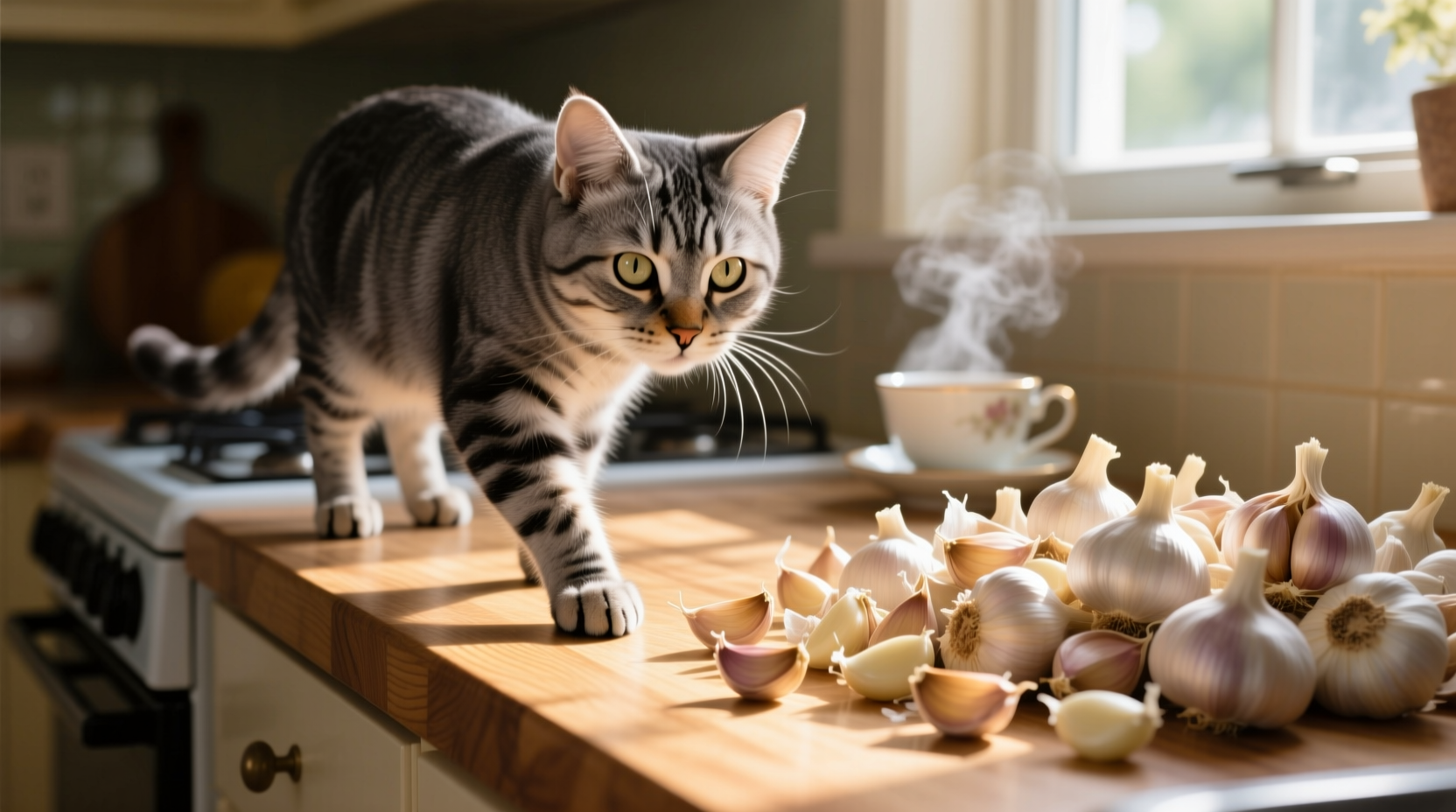Garlic might be a kitchen staple in your home, but for cats, it's a silent killer. Unlike humans who can safely enjoy garlic in moderation, cats lack the necessary enzymes to metabolize the toxic compounds found in Allium family plants. Understanding this danger could save your cat's life.
The Science Behind Garlic Toxicity in Cats
Garlic contains thiosulfate, a compound that causes oxidative damage to red blood cells in cats. When these cells rupture (a condition called hemolysis), it leads to hemolytic anemia. Cats are particularly vulnerable because they have lower levels of the enzyme glutathione that helps protect red blood cells from oxidative damage.
"Cats lack the metabolic pathway to safely process organosulfides found in garlic," explains Dr. Jennifer Coates, DVM, writing for Veterinary Partner. "This makes them significantly more susceptible to garlic toxicity than dogs or humans."
| Species | Metabolic Capability | Relative Risk from Garlic |
|---|---|---|
| Cats | Very limited ability to metabolize thiosulfates | Extremely High |
| Dogs | Moderate ability to metabolize thiosulfates | Moderate |
| Humans | High ability to metabolize thiosulfates | Very Low |
This comparative metabolic capability explains why what's harmless for humans becomes dangerous for cats. The ASPCA Animal Poison Control Center confirms that all members of the Allium family (garlic, onions, leeks, chives) pose significant risks to feline health.
Symptoms of Garlic Poisoning: What to Watch For
Symptoms typically appear 1-5 days after ingestion as the red blood cells gradually break down. Early signs include:
- Lethargy and weakness
- Pale or yellow-tinged gums
- Decreased appetite
- Vomiting
- Increased heart rate
As toxicity progresses, you might notice:
- Dark-colored urine (resembling cola)
- Rapid breathing
- Abdominal pain
- Collapse
The Cornell University College of Veterinary Medicine notes that symptoms can be delayed, making it difficult to connect your cat's illness with garlic exposure that happened days earlier.
How Much Garlic Is Dangerous? Understanding Toxic Doses
Unlike many toxins, there's no safe threshold for garlic consumption in cats. Research published in the Journal of Veterinary Pharmacology and Therapeutics indicates that as little as 15-30 grams of garlic per kilogram of body weight can cause toxic effects.
For perspective, a single garlic clove weighs approximately 3-7 grams. This means even a small amount—like what might be left on a plate or in food scraps—could harm your cat. The risk increases with:
- Kittens and senior cats
- Cats with pre-existing health conditions
- Repeated small exposures (cumulative effect)
- Concentrated forms like garlic powder (5-10x more potent than fresh garlic)
Many cat owners don't realize that garlic appears in unexpected places:
- Homemade pet treats
- "Natural" flea repellents
- Some commercial cat foods (as flavor enhancer)
- Leftover human foods like pizza, pasta sauces, and seasoned meats

What to Do If Your Cat Eats Garlic: Emergency Protocol
If you suspect your cat has consumed garlic, immediate action is critical:
- Don't wait for symptoms—contact your veterinarian or the ASPCA Animal Poison Control Center (888-426-4435) immediately
- Document everything—note the time of exposure, estimated amount consumed, and form (fresh, powder, cooked)
- Don't induce vomiting unless specifically instructed by a professional
- Bring the product packaging if available when visiting the vet
Treatment typically involves:
- Activated charcoal to absorb remaining toxins
- Intravenous fluids to support kidney function
- Oxygen therapy for severe anemia
- Blood transfusions in critical cases
According to the Pet Poison Helpline, early intervention dramatically improves outcomes. Cats treated within 12 hours of ingestion typically recover fully, while delayed treatment can lead to permanent organ damage.
Preventing Garlic Exposure: Practical Safety Measures
Prevention is always better than treatment when it comes to garlic toxicity:
- Store garlic securely—keep bulbs and powders in closed cabinets away from countertops
- Dispose of food scraps carefully—use sealed trash containers inaccessible to curious cats
- Read pet food labels—avoid products containing garlic, onion, or Allium derivatives
- Educate family members—especially children who might share "treats" with the cat
- Avoid homemade diets unless formulated by a veterinary nutritionist
Remember that garlic toxicity isn't just about intentional feeding. Cats exploring kitchen counters might nibble on food scraps containing garlic without your knowledge. The American Veterinary Medical Association emphasizes that prevention through environmental management is the most effective strategy for keeping cats safe.
Related Allium Family Dangers: Beyond Just Garlic
Garlic isn't the only kitchen ingredient that poses risks. All members of the Allium family are toxic to cats:
- Onions—more commonly encountered but slightly less potent than garlic
- Leeks—similar toxicity profile to garlic
- Chives—both regular and Chinese varieties are dangerous
- Shallots—concentrated form with high toxicity
The toxic principle (thiosulfate) is present in all parts of these plants—bulbs, leaves, and flowers. Cooking doesn't reduce toxicity; in fact, some preparation methods may concentrate the harmful compounds. Even garlic or onion powder in small amounts can be dangerous due to their concentrated nature.











 浙公网安备
33010002000092号
浙公网安备
33010002000092号 浙B2-20120091-4
浙B2-20120091-4